‘It is horrifying to look back and realise that my interest in astronomy started before the so called ‘space race’ but that is exactly what happened’.
My earliest memory of being involved in astronomy occurred when I was just five years old, in 1951. My teacher, Hugh Hamilton, instructed us all in the class to bring in a photograghic negative, in order that we could safely observe a partial eclipse of the Sun
My main interest began with a comet, Arend/Roland 1957 111 in April 1957. It had been discovered by two Belgian amateurs a few weeks before. I can well remember my late Father standing me on the wall of my old home at Lower Ballinderry and pointing out the wisp of dust and gas in the northern sky. At that time when just eleven years old, I was excited at having a Father who, while not seriously interested in astronomy himself, nevertheless had a passing interest from his days of doing night-duty on the RUC before the war.
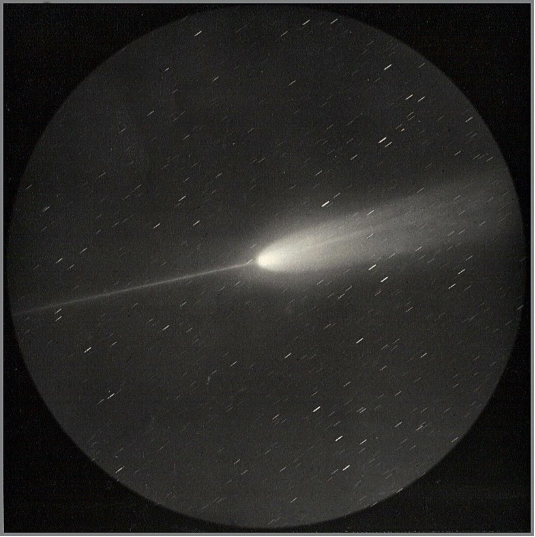
Comet Arend/Roland 1957 III taken 25th April 1957
with the Armagh Schmidt by Dr EM Lindsay. (Armagh Observatory).
My first telescope was made from a couple of spectacle lenses bought from a local optician, Walter Forbes in Lurgan, and this, surprisingly, showed me the craters of the moon and the moons of Jupiter, among other delights such as the Pleiades star cluster (Seven Sisters), the Orion Nebula and M31 (the Andromeda Galaxy). I was fascinated, or hooked, and often stayed out past my bedtime, often to my peril! Just starting on television at this time was a programme called “The Sky at Night” which was first broadcast in April 1957, with a fresh-faced presenter called Patrick Moore. As he was breaking new ground in broadcasting, most of his early shows were geared towards the casual watcher of the sky. The programme went on air at 10.30 p.m.
I started corresponding with Patrick and was always excited to get a reply. Then came a big event for someone just starting in astronomy. Patrick had been invited to come to Armagh and establish Irelands first planetarium, the first major project outside of London. He lived in one of the old ivy-covered Georgian houses in Armagh’s beautiful Mall, the house that was once owned by James Patterson Best. I can well remember numerous visits to his study, and the generous hospitality of Patrick and his mother.
On one of those visits Patrick proposed me for membership of the BAA (British Astronomical Association), a membership I still hold to this day, and I was a member of its Lunar section for many years. It was as a member of the Solar Section, under WM Baxter, that I first became acquainted with Bruce Hardie, who I can say here without doubt, is one of the main reasons I am still interested in astronomy. Without the help and encouragement in those early years of Bruce and Patrick I would have thrown in the towel years ago. At that time, the mid 60’s, I was serving my time as a cabinet maker and often had the job as lorry helper. The driver knew of my interest in astronomy and I often spent my lunch hour is Bruce’s office in the BBC where he was Outside Broadcast Manager. Sometimes, if Bruce was busy, we spent our lunch time down at the docks and looked across at the Canberra Liner or the Sea Quest oil platform being built!
In those early days at home we had no phone and to ring Bruce at work or home I had to cycle about a mile to the nearest telephone box. After the usual introductions with Pat Lee, his secretary, I was greeted with great enthusiasm. Recently while looking through some old material I was delighted to find some of Bruce’s excellent prints of sunspots along with some old 2” glass slides which he made himself. Needless to say, I am still very interested in solar work, and now use an ETX 90mm and a PST for Ha work, times have changed in a big way from observing the sun by projection onto a card!
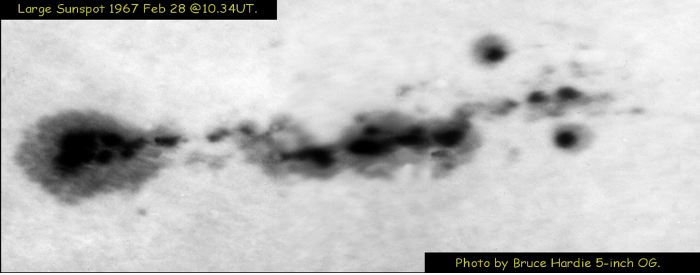
One of Bruce’s images from February 1967.
By now my telescope was a little refractor with an object glass of just 40mm. This, of course, by today’s standards was quite useless, but to me it was like Palomar compared to the cardboard tubes and spectacle lenses. I well remember Patrick Moore getting down on one knee and looking through it in his study and explaining “very good objective” in an ever-encouraging tone! But this was still not what I had in mind, somewhere in the back of my mind there was this idea of having my own observatory but it was to be a few years before that would come about. I still used this little scope well into the 70’s and actually observed Bennett’s comet through it in April 1970.
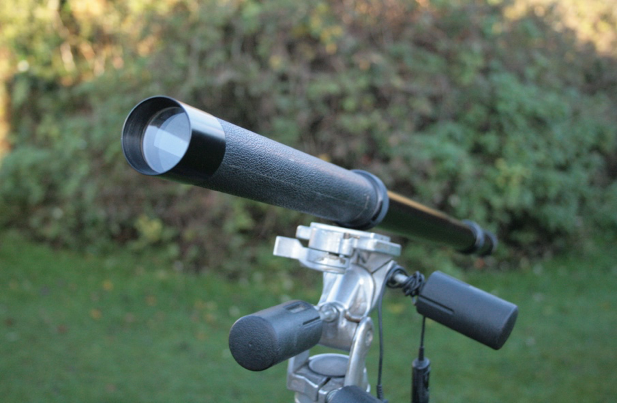
My first real telescope with a 40mm OG on a modern tripod.
It was at this time that I discovered that Armagh had an observatory and my first visit there was in 1963, and I followed this with my first visit to Dunsink, on 27the March 1967, where a new Director had been appointed a few months earlier in the person of Prof Patrick Wayman. In later years Wayman and I would become close friends. I soon found out from my visits to Armagh that the Director there, Dr Eric M. Lindsay, was actually related on my grandmother’s side of the family, and a long and lasting friendship was struck up which only ended with his sudden death in July 1974. So, with that background it was inevitable that astronomy would be my hobby! Strangely enough, on all those visits to Armagh at that time I never used the famous 10” Grubb refractor, that would come later!
I upgraded to a 60mm refractor, and used that for a number of years, and then had a 4-inch reflector, but I still had bigger ideas. I bought an 8.5-inch mirror from Ernest W Mason of Southampton but this was never mounted, except for trials. Then, in about 1967, I bought a 6-inch mirror from Henry Wildey, another celebrated mirror maker of the time, and I mounted it in a tube of PVC, at first on a home-made wooden mount, (these were the days before Dobsonions). After a while I bought a Fullerscopes equatorial mount but could not afford the trimmings. My brother’s father-in-law worked in Mackies Foundry, which was helpful as he was able to make the counterweights, the cast iron pillar came from a scrapyard at my father’s expense.
We then proceeded to get something off the ground in the form of an observatory, but we were warned not to make it too conspicuous as we were close to a main road. The design was entirely due to my father who also did most of the building. The dome took the shape of a pyramid in four sections, which, on one occasion, blew off in a violent gale, so he devised fasteners on the inside to ensure that that wouldn’t happen again. The building was built around the cast iron pillar which was anchored in concrete, with a gap so it did not actually touch the floor, so as to eliminate vibration. A study area was at the western end with electric brought by wire from the kitchen to enable a red light to be installed for observation.
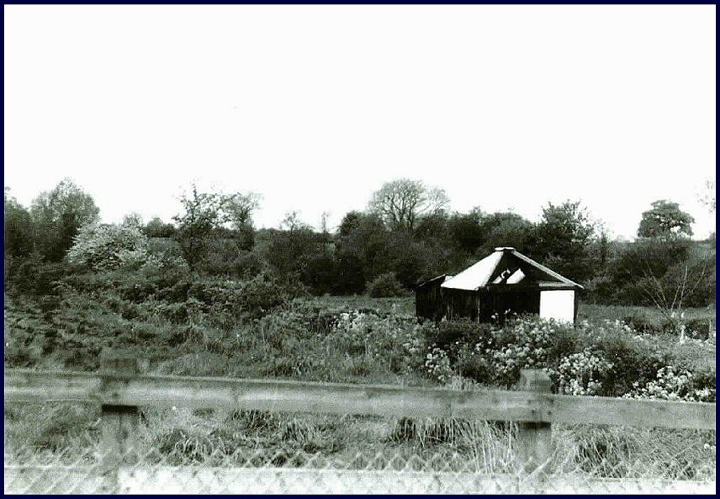
The observatory in the late 1960’s showing the telescope through one of the removed sections.
The telescope was mounted on the pillar and during observation one section of roof could be removed at a time to enable shelter. I relate to a story I have told many times. One night while observing late into the night in the observatory, a bark like that from a banshee rang out in the silence of the night and my feet never touched the ground till I hit the kitchen! It was springtime and a Vixen out looking for a mate was the culprit. It was a hair raising experience to say the least! We lived in a dip of the road and at night there was often no sound to be heard, and on a still night you could often hear the old steam freight train chugging up the Ballinderry line several miles away. It was comfortable even though it had no heating. You could also lock yourself in if need be to feel safer in the middle of the night! All my telescopes were mounted on the mount, the 6-inch, the 60mm, and the 4-inch plus a small finder.
One of the first people to look through the scope was a schoolboy called Samuel Lyttle, who, even back then, was talking of a career in astronomy. Sam was a lifelong friend who we sadly lost quite recently, but his enthusiasm for all things astronomical was unsurpassed.

My scope the early 1970’s
Many happy hours were spent in that old observatory, chiefly observing the moon and planets, doing TLP (Transient Lunar Phenomenon) work for the Lunar Section and many other Sections. Many TLP’s were observed that I remember well. One was in a crater called Cichus in the Palus Epidemiarum (Marsh of Epidemics) that caused a bit of excitement, and another in Gassendi not far to the north. I used a TLP blink filter made by Harry Ford from Mechano with red and blue filters, the idea was to switch them back and forth from one colour to the other revealing the ‘hot’ spot which would appear light in the red and dark in the blue. A systematic search was made of many possible areas in one night, and many observations were reported to either Patrick or Phil Ringsdore, who wrote the newsletter. The TLP Network was originally set up by Patrick Moore and Dr Barbara M Middlehurst in the USA.
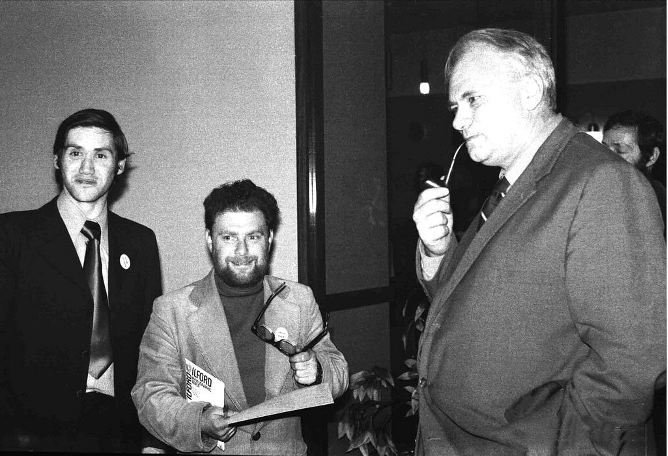
With Patrick Moore and Dr Harry Ford in Dundee May 1974.
BAA Lunar Section Meeting. (Ken Kennedy).
It was about this time that I first noticed these strange luminous pearly blue clouds in the northern sky on summer evening’s, and wondered what the heck they could be. I knew full well they were not aurora so they had to be something else! It was only later when I became friends with guys from Dundee that I discovered they were Noctilucent Clouds or Night Shining Clouds. These form at about 80 kilometres up at the edge of the atmosphere and are thought to be meteoritic dust, finer than cigarette smoke, encased in ice. Needless to say, this phenomenon has been a keen interest of mine for a lifetime!
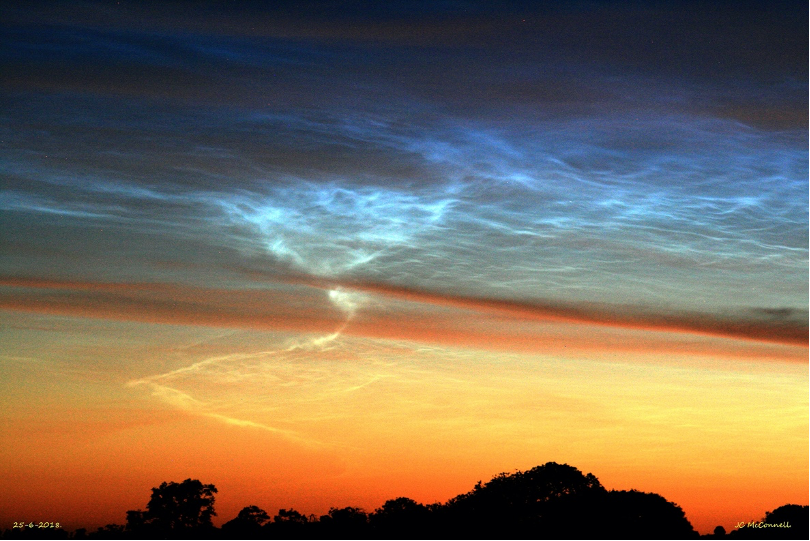
An NLC display from June 2018.
By now it was coming close to a new decade, and I was beginning to get myself noticed. The first satellites had gone into space, and more importantly, man had walked on the moon. Other great astronomical events spring to mind, such as the Bovedy Meteorite on April 25th 1969, and Bennett’s great comet in 1970. The Bovedy Meteorite was something special. I remember that Friday evening with great affection. It was like a summer’s evening, the sun had just gone, hardly a cloud could be seen, it was 8.30pm. My parent’s and I were visiting my uncle and aunt’s house in Waringstown just outside Lurgan. We had all just returned from a walk down the orchard and as we reached the back entrance I just happened to be the last one going into the house. On the flag stones I noticed what appeared to be lightning, but I knew there was little cloud. Presence of mind told me to look up, and what a sight was waiting. This great ball of fire about the size of the full moon with bits falling off was racing across the sky heading north-west. I couldn’t believe my eyes. All I could do was stand and watch as it headed out over Lurgan. I was still shaking about an hour later! Of course, it turned out to be the largest meteorite to hit Ireland since the Crumlin fall in 1902. Several pieces were found but the main bulk hit the sea off Malin Head, Co. Donegal. Fragments can still be seen in Armagh Planetarium.
I only managed to see Bennett’s Comet once, on April 1st 1970, as it was cloudy every other morning. I awoke that morning by chance at about 4.30am. When I looked out the window there it was in all its beauty, hanging like a great quill pen in the east. Only a couple of photos were taken in b/w with a wee brownie camera. I was still able to observe it well after the sun had risen. Little did I know at that time that we would see other so called “great” comets in the following years. Sometime later, while in London for the BAA Exhibition meeting, Patrick Moore introduced me to John C Bennett of Pretoria, South Africa, who discovered it. It was such a thrill, and the first comet hunter/discoverer I had ever met!
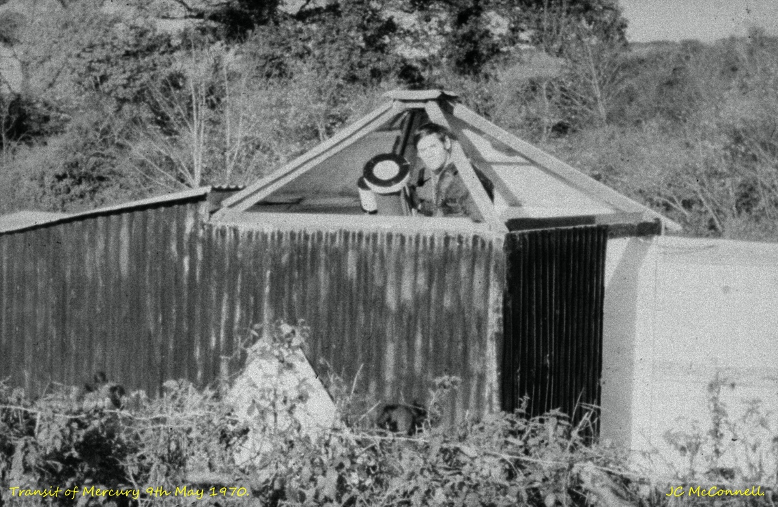
Observing the transit of Mercury on May 9th 1970
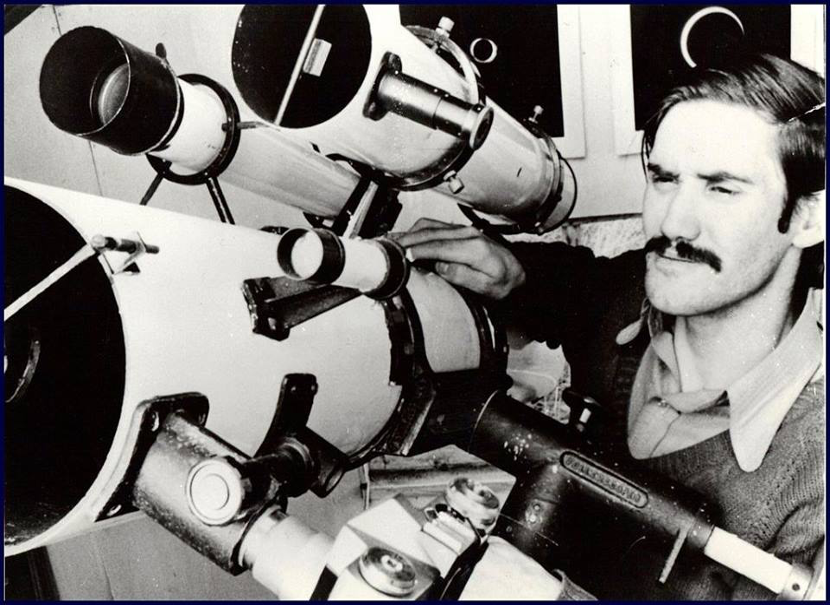
Myself with my scopes in October 1978 (Belfast Telegraph)
Comet Kohoutek 1973 E1 in early 1974 was hyped by the media to be the “Comet of the Century” but turned out to be somewhat of a flop. It was discovered on 7th March 1973 by Czech astronomer Lubos Kohoutek and would attain perihelion on 28th December. But the weather over Christmas and New Year was horrible and nothing could be seen from most of the United Kingdom. So other arrangements had to be made if I was to see it. On the Sunday evening the 3rd of January 1974 an old school friend and I contacted Captain Mike Woodgate, of Woodgate Aviation, and we took aloft in a single engine Piper Cherokee to 5,800ft over a dark and forbidding Lough Neagh in search of Kohoutek. After a while the comet was spotted very low in the west-southwest dusk twilight, in 10×50 binoculars and at fourth magnitude; As I was sitting in the front Mike said to me “I want a look as well” so I had to hold the plane level while he viewed the comet! This information was relayed to Patrick Moore, who was being pestered by the media for a magnitude estimate, but nobody else he knew had seen it! Patrick passed it straight to the London Times and my observation was on the front page next day! Patrick followed this with a flight of his own to 33,000ft over the Irish Sea on January the 10th but the comet was still only fourth magnitude. The public would remember Kohoutek as a flop and the integrity of astronomers was certainly damaged by the press hype, nevertheless it became a good comet for well-equipped amateur astronomers in the weeks to come.
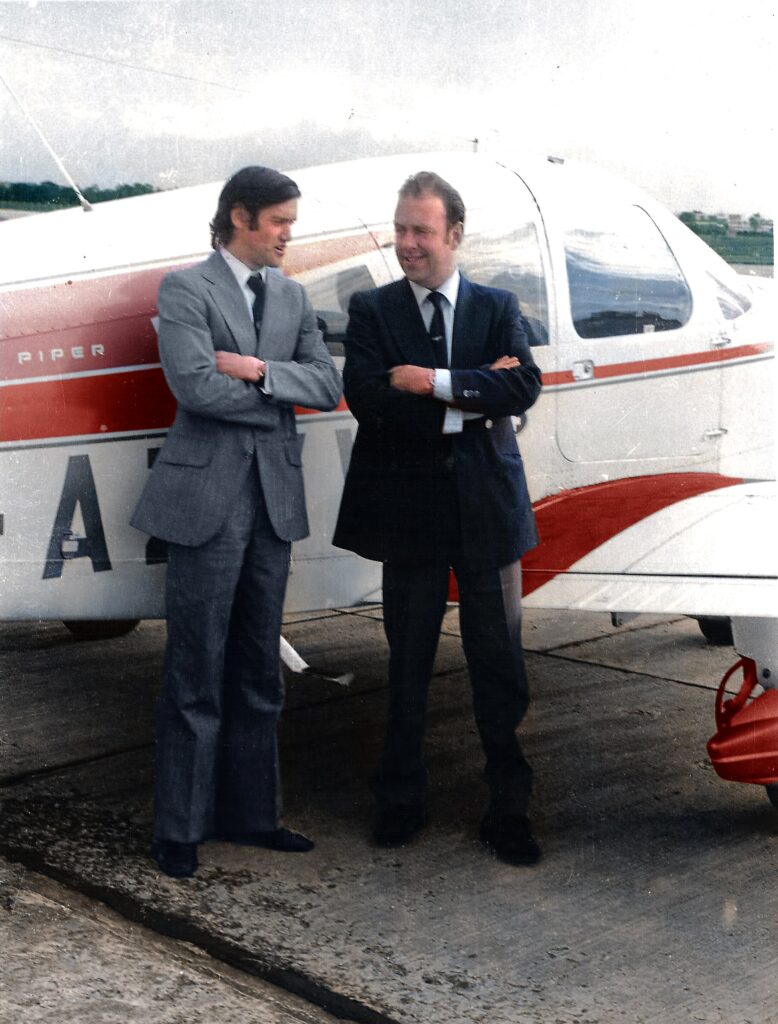
Captain Mike Woodgate and myself beside the very aircraft we flew to see Kohoutek in January 1974 (Updated image now professionally coloured by Ted Dobosz from Sydney Australia)
It just goes to show that you can make an impact in your hobby of astronomy if you persist, even with very simple equipment, and with the help of a good family and friends. I just hope that this short article has given the reader some encouragement to do just that.
John McConnell…December 2020
